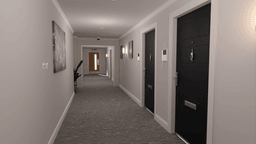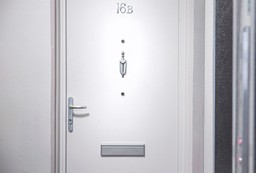Where Are Fire Doors Required in the UK? An Overview
Fire doorsets are an essential safety feature in buildings, designed to prevent the spread of fire and smoke. Whether you’re in a residential home or a commercial property, understanding where fire doors are required in the UK is crucial to ensuring the safety of occupants and meeting legal standards. Fire door requirements are set out… Continue reading Where Are Fire Doors Required in the UK? An Overview
Fire doorsets are an essential safety feature in buildings, designed to prevent the spread of fire and smoke. Whether you’re in a residential home or a commercial property, understanding where fire doors are required in the UK is crucial to ensuring the safety of occupants and meeting legal standards. Fire door requirements are set out by UK fire safety regulations, and it’s important to comply with them to safeguard lives and property.
In this article, we will explore fire door requirements in the UK, explaining where fire doors need to be installed, the fire door regulations, and what you need to know to ensure compliance in both domestic and commercial properties.
Key Takeaways
- Fire Doors in Non-Domestic Properties: Required in all businesses, factories, public buildings, and other commercial properties.
- Fire Doors in Residential Properties: Mandatory in houses with three or more storeys, flats, and Houses in Multiple Occupation (HMOs).
- Regulations: Compliance with the Fire Safety Order is required for both residential and non-residential properties.
- FD30(S) Fire Doors: These are the standard fire door rating required, offering 30 minutes of fire and smoke resistance.
- Maintenance and Inspections: Fire doors must undergo regular checks and maintenance to ensure they function properly.
FD30(S) Fire Doors: What You Need to Know
When it comes to the fire door regulations in the UK, it’s important to understand the different fire ratings. The most common rating for fire doors is FD30(S), providing 30 minutes of fire and smoke resistance. Certain applications will need a higher rating, such as FD60(S) for an hour of resistance.
Why Choose FD30(S) Fire Doors?
- Fire Resistance: FD30(S) fire doors prevent the spread of fire and smoke for at least 30 minutes.
- Smoke Seals: The “(S)” in FD30(S) indicates that the door is also equipped with smoke seals.
FD30(S) fire doors are required in both domestic and non-domestic properties and are the minimum standard for most buildings. To learn more, explore either of our popular ranges – the Safer Homes Range or the Contemporary Range – which are also available rated as FD60(S).
Fire Door Requirements in Non-Domestic Properties
In the UK, fire doors are mandatory in all non-domestic properties such as businesses, factories, commercial buildings, and public spaces. These doors play a vital role in ensuring the safety of employees, customers, and the building’s infrastructure in case of a fire.
Where Are Fire Doors Required in Non-Domestic Properties?
Fire doors must be installed in key areas of non-domestic buildings, including:
- Escape Routes: Fire doors are necessary to form clear horizontal and vertical escape routes. These are escape routes that help occupants evacuate quickly and safely in case of a fire. In larger buildings, fire doors also serve to divide areas into fire-resistant zones, preventing the fire from spreading rapidly throughout the property.
- Common Areas: For buildings with multiple tenants or businesses, fire doors are required in common areas like corridors, stairwells, and entrances to individual units. This helps contain fire and smoke within a specific section of the building, allowing residents and employees to escape more easily.
Properly installed fire doors in non-domestic buildings contribute significantly to fire safety by helping compartmentalise fire and ensuring that escape routes remain safe and accessible.
Fire Door Regulations for Domestic Properties
Fire doors are also critical in domestic properties, especially in multi-storey homes and buildings with multiple residents. The fire door regulations in residential properties are slightly different from those in commercial spaces, but they are just as important to ensure safety.
Houses with Three or More Storeys
In homes with three or more storeys, fire doors are required in specific locations to prevent the spread of fire and to allow for safe evacuation:
- Between Habitable Rooms and Stairwells: Fire doors must be installed between any habitable room and a stairwell. This ensures that fire or smoke cannot travel quickly between floors, providing the residents time to escape.
- In Internal Garages or Converted Lofts: If a house has an integral garage or a converted loft, fire doors must be installed at the entrance to the house from these areas. This is because garages and lofts may contain items that could easily catch fire, so the door helps contain the fire and prevents it from spreading into the rest of the house.
These fire door installations in multi-storey homes ensure that residents can escape safely, even if one part of the building is affected by fire.
Fire Door Regulations for Flats and Apartments
Flats and apartment buildings are subject to their own set of fire door requirements. In high-rise buildings, especially those that have multiple flats or apartments, fire safety is particularly crucial. Fire doors are an essential part of keeping both the residents and the building safe.
Fire Doors in Flats: Key Requirements
- Flat Entrance Doors: Every flat in a multi-occupancy building must have a fire-rated entrance door. These doors help to prevent the spread of fire from one flat to another and allow residents a safe exit if necessary.
- High-Rise Flats: Flats located more than 4.5 meters above ground level have additional fire door requirements. In these buildings, fire doors must be installed between habitable rooms and the hallway. This ensures that fire cannot spread quickly between rooms and that residents have time to evacuate safely. Additionally, fire doors are required at the entrance to each flat.
These fire door regulations are essential in buildings where multiple households live in close proximity to each other. Fire doors help to prevent the fire from spreading quickly and give everyone enough time to evacuate.
Fire Door Regulations for Tall Buildings
Buildings over 11 meters in height have additional fire safety requirements. In such buildings, fire doors must be regularly checked to ensure they remain in proper working condition.
Fire Door Requirements for Tall Buildings
- Entrance Doors to Flats and Rooms: Landlords must ensure that the front doors leading into individual flats or rooms are fire doors. This is crucial because fire can spread quickly in shared spaces, and fire doors help prevent this by creating fire-resistant barriers between rooms.
- Escape Routes: Fire doors should also be part of the escape routes, ensuring that tenants can evacuate the building safely in case of fire. Fire doors are needed in stairwells, corridors, and communal areas.
These additional inspections are crucial because fire doors are the primary means of containing fire and smoke in tall buildings.
Fire Door Maintenance and Inspections
Regular maintenance and inspection of fire doors are critical to ensure that they perform effectively during an emergency. Without regular checks, fire doors may not close properly or may fail to provide adequate protection.
Regular Maintenance Tips
- Check for Obstructions: Ensure that fire doors can close completely and that nothing is blocking them. Also confirm that the closer functions correctly.
- Inspect Smoke Seals: Check that smoke seals are in good condition.
- Examine Signage: Ensure that the appropriate signage remains in place on the doorset.
For more information on fire door compliance and fire door regulations, visit our knowledge centre or check out our page on fire doors for commercial buildings.




